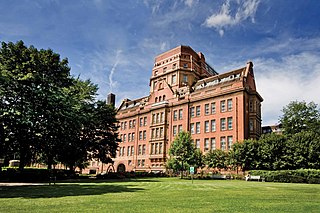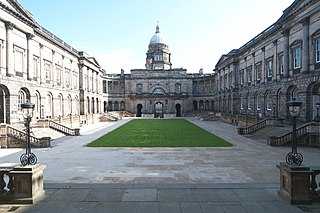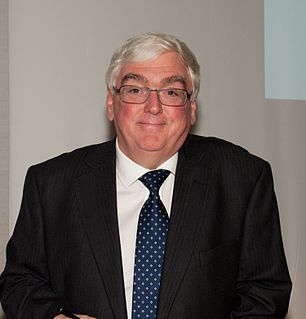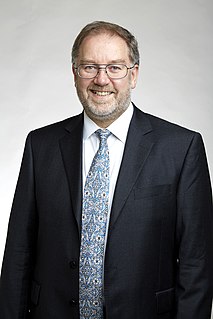In materials science, a metal matrix composite (MMC) is a composite material with fibers or particles dispersed in a metallic matrix, such as copper, aluminum, or steel. The secondary phase is typically a ceramic or another metal. They are typically classified according to the type of reinforcement: short discontinuous fibers (whiskers), continuous fibers, or particulates. There is some overlap between MMCs and cermets, with the latter typically consisting of less than 20% metal by volume. When at least three materials are present, it is called a hybrid composite. MMCs can have much higher strength-to-weight ratios, stiffness, and ductility than traditional materials, so they are often used in demanding applications. MMCs typically have lower thermal and electrical conductivity and poor resistance to radiation, limiting their use in the very harshest environments.

Julia Elizabeth King, Baroness Brown of Cambridge is a British engineer and crossbench member of the House of Lords, present Chair of the Carbon Trust and the Henry Royce Institute, and was the Vice-Chancellor of Aston University from 2006 to 2016.
Vernon Charles Gibson is a British scientist who served as Chief Scientific Adviser at the Ministry of Defence between 2012 and 2016. He is visiting professor at Imperial College London and the University of Oxford, Honorary Professor at the University of Manchester and Executive Chair of the BP International Centre for Advanced Materials.

Sir Alan Howard Cottrell, FRS was an English metallurgist and physicist. He was also former Chief Scientific Advisor to the UK Government and vice-chancellor of Cambridge University 1977–1979.

The Department of Materials, at the University of Manchester is an academic and research department specialising in Materials Science and Engineering and Fashion Business and Technology. It is the largest materials science and engineering department in Europe. This is reflected by an annual research income of around £7m, 60 academic staff, and a population of 150 research students and 60 postdoctoral research staff. The Department of Materials was formerly known as the School of Materials until a faculty-wide restructuring in 2019.

The Department of Materials Science and Metallurgy (DMSM) is a large research and teaching division of the University of Cambridge. Since 2013 it has been located in West Cambridge, having previously occupied several buildings on the New Museums Site in the centre of Cambridge.

Brian Leonard Eyre CBE, FRS, FREng was a British material scientist, Chief Executive of the United Kingdom Atomic Energy Authority (UKAEA) and Professor at the University of Liverpool. He was also a visiting scholar at the University of Oxford and University College London.
Derek John Fray is a British material scientist, and professor at the University of Cambridge.

Sir John Vincent McCanny is the emeritus Regius Professor of Electronics and Computer Engineering at Queen's University Belfast, and director of the Institute of Electronics, Communications and Information Technology.

Sir Harshad"Harry"Kumar Dharamshi Hansraj Bhadeshia is an Indian-British metallurgist and Emeritus Tata Steel Professor of Metallurgy at the University of Cambridge. In 2022 he joined Queen Mary University of London as Professor of Metallurgy.
The A. A. Griffith Medal and Prize is awarded annually by the Institute of Materials, Minerals and Mining in commemoration of Alan Arnold Griffith.

The Regius Chair of Engineering is a royal professorship in engineering, established since 1868 in the University of Edinburgh, Scotland. The chair is attached to the University's College of Science and Engineering, based in the King's Buildings in Edinburgh. Appointment to the Regius Chair is by Royal Warrant from the British monarch, on the recommendation of Scotland's First Minister.

John Paul Attfield is a Professor of Materials science in the School of Chemistry at the University of Edinburgh and Director of the Centre for Science at Extreme Conditions (CSEC).

Raymond Edward Smallman was a British metallurgist and academic known for his research into alloys and the causes of metal fatigue. Smallman was also a significant figure at the University of Birmingham, serving as its vice-principal between 1987 and 1992 and helping to establish its reputation as a leading modern research university.

Sir John Michael Brady is an Emeritus professor of Oncological Imaging at the University of Oxford. He has been a Fellow of Keble College, Oxford since 1985 and was elected a foreign associate member of the French Academy of Sciences in 2015. He was formerly BP Professor of Information Engineering at Oxford from 1985 to 2010 and a Senior Research Scientist in the MIT Computer Science and Artificial Intelligence Laboratory (CSAIL) in Cambridge, Massachusetts, from 1980 to 1985.

Paul O'Brien was professor of Inorganic Materials at the University of Manchester. where he has served as head of the School of Chemistry from 2004 to 2009 and head of the School of Materials from 2011 to 2015. He died on 16 October 2018 at the age of 64.
Robert Joseph Young is a British materials scientist specialising in polymers and composites. He is a Professor of Polymer Science and Technology at the National Graphene Institute of the University of Manchester.

Sir Robin William Grimes is chief scientific adviser in the Ministry of Defense (MoD) for nuclear science and technology and professor of materials physics at Imperial College London. From February 2013 to August 2018 he served as chief scientific adviser to the Foreign and Commonwealth Office (FCO). Since November 2021 he has been Foreign Secretary of The Royal Society

The Department of Materials is responsible for the teaching and research in materials science and engineering at Imperial College London, occupying the Royal School of Mines and Bessemer buildings on the South Kensington campus. It can trace its origins back to the metallurgy department of the Government School of Mines and Science applied to the Arts, founded in 1851.
Allan Matthews (1952) is Professor of Surface Engineering and Tribology at The University of Manchester and Director of the Digitalised Surfaces Manufacturing Network.














